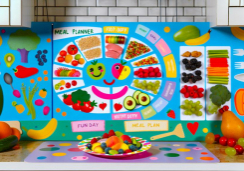Mastering Diabetes Management With Strategic Meal Planning
Just as a compass provides direction to a traveler in unknown territory, a strategic meal plan offers you guidance in the complex journey of managing diabetes. You're well aware that what you eat directly influences your blood sugar levels, weight, and overall health, but perhaps you're grappling with the practicalities of what that looks like on a daily basis.
By carefully crafting your meals, you can demystify the process, making it more manageable and less time-consuming. You'll discover how to select foods that support your health goals, learn the art of balancing macronutrients, and understand the significance of meal timing.
With a well-thought-out plan in hand, you're set to navigate the challenges ahead, but there's more to this than just following recipes and shopping lists. Stick with me to uncover the subtleties that turn a simple meal plan into a powerful tool in controlling your diabetes and enhancing your life quality, without feeling overwhelmed by the dietary constraints that often come with this condition.
Understanding Carbohydrate Counting
To effectively manage your blood sugar levels, it's important to grasp the basics of carbohydrate counting and learn how to track the carbs in your meals and snacks accurately. This method is a cornerstone of a meal plan that makes sense for someone with diabetes, aiming to lower blood sugar and achieve the best A1c results.
By focusing on foods like whole grains, you're not only opting for nutrients that give you a green light for better health but also taking strides to reverse insulin resistance.
Carbohydrate counting doesn't have to be daunting; it can be an easy-to-follow system that fits seamlessly into your lifestyle. Start by familiarizing yourself with the carb content of foods you commonly eat, and use measuring tools or apps to help estimate portions accurately. This practice empowers you to make informed decisions about your diet, ensuring that you can enjoy a variety of foods while keeping your blood sugar in check.
Balancing Macronutrients
Striking the right balance of carbohydrates, proteins, and fats in your meals is crucial for managing blood sugar and supporting your overall health. To lower blood sugar fluctuations and maintain a healthy weight, it's essential to understand how these macronutrients work together.
Every meal should include a mix of these nutrients to stabilize blood glucose levels and decrease insulin use.
Carbohydrates are your body's primary energy source but choose whole grains, fruits, and vegetables over processed options to prevent spikes in blood sugar.
Proteins are vital for repairing tissues and maintaining muscle mass; incorporating lean proteins can help you feel full longer.
Fats, especially those from healthy sources like avocados and nuts, are necessary for nutrient absorption and satiety.
To simplify this process, seek out a New York Times best-selling recipe guide that specializes in meals for diabetes management. Such resources often provide an easy-to-follow grocery list, ensuring that you have all the nutritious ingredients you need.
Remember, balancing macronutrients isn't just about the numbers; it's about making sustainable, enjoyable changes to your diet that support your health goals.
Consult with a healthcare professional to tailor these guidelines to your specific needs, making meal planning a powerful ally in your diabetes management strategy.
Incorporating Low-GI Foods
Incorporating low-GI foods into your diet can significantly stabilize your blood sugar levels, enhancing insulin sensitivity and overall health management. On your journey to lower blood glucose, understanding the role of these foods is crucial in mastering diabetes.
Low-GI foods, which include whole grains, legumes, nuts, seeds, fruits, and non-starchy vegetables, provide a slow and steady release of glucose. This can help you maintain energy levels without the spikes and crashes that high-GI foods might cause.
Adding these nutrient-dense choices doesn't just support your blood sugar; it can also aid in weight management and reduce the risk of chronic diseases. They promote a sense of fullness, helping to curb cravings and prevent overeating. As you explore specific diets and approaches to health, testimonials often highlight the benefits of a low-GI focus. However, remember that these approaches to health represent individual experiences.
To simplify your journey, seek out resources offered by trusted healthcare providers. They can provide personalized, professional medical advice and help tailor a meal plan that incorporates low-GI foods effectively. You don't have to shop to simplify your diet alone; professional guidance can ensure your nutritional choices align with your health goals.
Meal Timing and Frequency
Understanding the importance of meal timing and frequency can empower you to take control of your diabetes and maintain steadier blood sugar levels throughout the day. By eating regular, balanced meals and spacing them evenly, you're not only stabilizing your blood sugar but also preventing extreme fluctuations that can be harmful to your health. Remember, health represents individual experiences, and what works for one person may not work for another.
Consistency is key in meal timing and frequency for optimizing insulin sensitivity and reducing the risk of insulin resistance. This consistent approach supports your metabolic health and contributes to overall better diabetes management. Mastering Diabetes may receive positive feedback from those who've found that structured meal plans with specific timing have significantly improved their specific situation.
The information on this site is for informational purposes, and the site isn't intended to replace professional medical advice. However, we're here to share resources offered that can guide you in creating easy and delicious meals that fit into your daily routine. Always consider your unique dietary needs and consult with your healthcare provider before making changes to your meal timing and frequency.
Monitoring and Adjusting Plans
Regular monitoring of your blood sugar levels is crucial to refine your meal plan and maintain optimal glucose control. As you track your responses to different meals, you'll notice patterns that can guide you to make necessary adjustments. Remember, diabetes doesn't guarantee uniform results for your specific condition, so it's essential to personalize your approach.
Here are some strategies to consider:
- Review your blood sugar readings to identify trends.
- Adjust portion sizes if you're consistently seeing high or low blood sugar levels.
- Consider the carbohydrate content and swap out foods that act as a red light for your glucose control.
- Use a yellow light approach for foods that require caution and moderation.
- Remain flexible and willing to substitute foods to match your preferences and lifestyle.
It's important to remember that this information isn't a substitute for professional medical advice. Always consult with a healthcare professional before making significant changes to your meal plan. Reviews and testimonials may inspire you, as thousands of people have successfully managed their diabetes, but there's no guarantee any results you see in others will be replicated in your own experience. Continue bringing you valuable insight into your health by staying vigilant and proactive.
Frequently Asked Questions
How Much Does the Mastering Diabetes Coaching Program Cost?
You'll pay $149 yearly for the program, a notable saving compared to its $349 value. This investment offers coaching benefits, membership tiers, and a cost-effective, long-term approach to diabetes management.
What Is the Most Popular Meal Planning Approach Used by Diabetics?
You'll find carbohydrate counting and the plate method are popular for managing diabetes. They focus on portion control, food pairing, and nutrient timing to stabilize blood sugar and aid in insulin adjustment.
What Is the Main Goal of Diabetes Meal Planning?
Your diabetes meal planning's main goal is to manage blood sugar through nutrient balance, portion control, and carb counting, considering glycemic index, healthy fats, fiber, meal timing, consistent eating, and personal preferences.
Is There a Free App for Diabetic Meal Planning?
Yes, you can find free diabetes-friendly apps that offer meal prep strategies, nutritional tracking, and features like portion control, carb counting, food logging, and personalized menus to help with blood sugar monitoring.
Conclusion
You've now got the tools to master your diabetes through strategic meal planning. By counting carbs, balancing macros, and choosing low-GI foods, you're set for success.
Remember, meal timing matters, and staying flexible allows you to adjust as needed. You're not just managing diabetes; you're reversing insulin resistance and paving the way to a healthier you.
Keep monitoring, keep learning, and celebrate each victory. You've got this!










